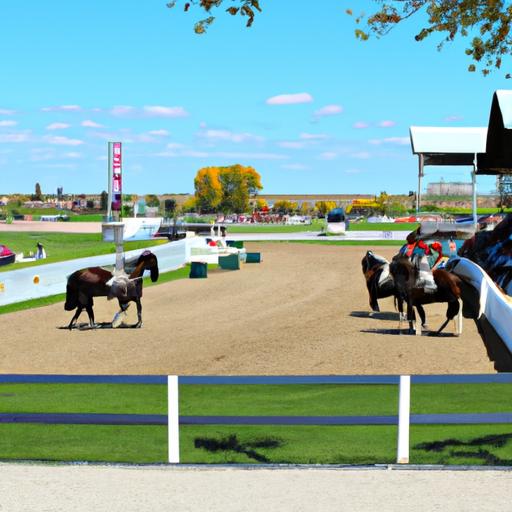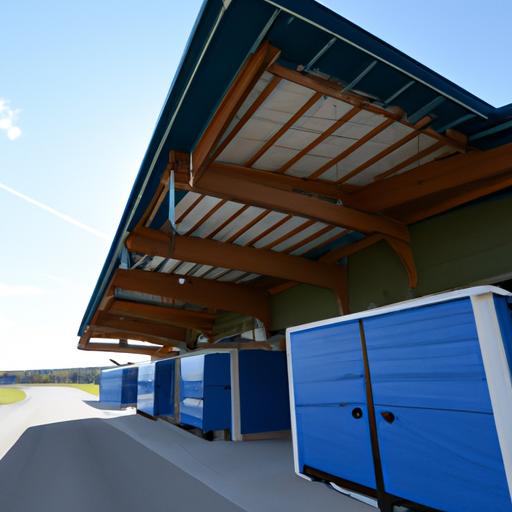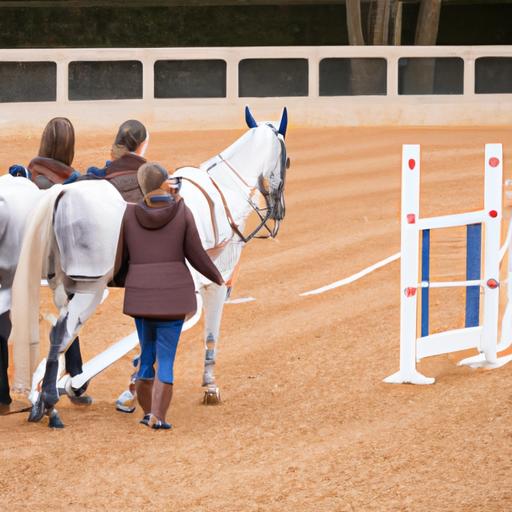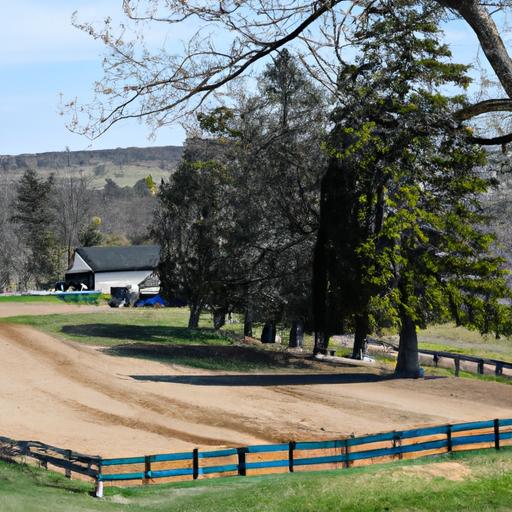Unlock the secrets to success in equestrian sports with our comprehensive guide to horse competition yards. Elevate your training and performance!
Introduction

As a passionate equestrian, have you ever wondered what sets top riders and horses apart? The answer lies in the meticulously designed and expertly managed horse competition yards. In this article, I will delve into the world of horse competition yards, exploring their definition and highlighting their significance in the realm of equestrian sports.
Definition of Horse Competition Yards
Horse competition yards are specialized equestrian facilities dedicated to training and preparing horses and riders for competitive events. These yards provide a nurturing environment where athletes can hone their skills, improve performance, and establish a strong foundation for success in the show ring or on the eventing course.
Importance of Horse Competition Yards for Equestrian Sports
Horse competition yards play a pivotal role in the world of equestrian sports. They serve as the epicenter of training, offering riders access to top-notch facilities, experienced coaches, and a supportive community. These yards act as a breeding ground for champions, nurturing talent and transforming aspiring riders into accomplished athletes.
For riders, horse competition yards serve as a sanctuary where they can focus solely on their craft. The yards provide a conducive environment that fosters discipline, dedication, and a relentless pursuit of excellence. With state-of-the-art training arenas, well-maintained stables, and access to specialized services, riders can elevate their skills and push their limits to achieve remarkable results.
But it’s not just riders who benefit from horse competition yards. Horses, the true stars of equestrian sports, also reap the rewards. These yards are designed to cater to the unique needs of each equine athlete, ensuring their physical and mental well-being. From spacious paddocks and comfortable stabling to specialized veterinary care and tailored nutrition plans, every aspect is meticulously crafted to optimize the performance and welfare of these magnificent creatures.
In the following sections, we will explore how to choose the right horse competition yard, understand the design elements that contribute to their success, and delve into the management practices that keep these yards thriving. So, let’s embark on this exciting journey together and unlock the secrets behind horse competition yards.
Choosing the Right Horse Competition Yard

Factors to Consider When Selecting a Horse Competition Yard
When it comes to selecting the perfect horse competition yard, several crucial factors should be taken into account. Let’s explore these considerations to ensure you make an informed decision.
1. Location and Accessibility
The location of a horse competition yard is paramount. Ideally, it should be easily accessible, minimizing travel time and stress for both you and your equine partner. Consider proximity to major competition venues, as well as transportation options for long-distance events. Additionally, evaluate the surrounding area for access to veterinary care, feed suppliers, and other essential equestrian services.
2. Facilities and Amenities
A well-equipped horse competition yard should boast a range of facilities and amenities that cater to the needs of both horses and riders. Look for spacious and well-ventilated stables, ample turnout areas, and high-quality footing in the training arenas. Adequate storage for equipment and feed is vital, along with well-maintained wash racks and grooming areas. Don’t forget to assess the availability and condition of amenities such as tack rooms, lounges, and on-site accommodation for trainers or riders.
3. Training and Coaching Services
The expertise and guidance provided by trainers and coaches are instrumental in achieving success in equestrian sports. Research the credentials and experience of the professionals associated with the horse competition yard. Determine if they align with your goals and aspirations, and inquire about their coaching methods and training programs. A yard with a diverse team of knowledgeable instructors can offer valuable insights and support your growth as a rider.
4. Reputation and Track Record
A horse competition yard’s reputation and track record are indicative of its success in nurturing talented riders and producing exceptional performances. Seek feedback from current and past clients, and explore the accomplishments of riders who have trained at the yard. Look for evidence of consistent results, both at local and national levels. A yard with a proven track record can instill confidence and provide a supportive environment for your equestrian journey.
How to Evaluate Horse Competition Yards
Evaluating horse competition yards can be a daunting task, but a systematic approach will help streamline the process. Start by creating a checklist of your requirements and preferences, then visit potential yards to assess their suitability. Engage in conversations with staff, trainers, and current clients to gather insights about the yard’s culture, management practices, and overall atmosphere. Take note of the condition of the facilities, the horses’ well-being, and the overall organization of the yard. Trust your instincts and choose a horse competition yard that aligns with your aspirations and values.
In the next section, we will delve into the design and layout of horse competition yards, unraveling the elements that contribute to their functionality and success. So, let’s continue our exploration together and uncover the secrets of these remarkable equestrian havens.
Design and Layout of Horse Competition Yards

Importance of Proper Design in Horse Competition Yards
When it comes to horse competition yards, design plays a crucial role in creating an optimal environment for training and competition. A well-designed yard not only enhances the functionality and efficiency of operations but also contributes to the overall well-being and performance of both horses and riders.
The layout and infrastructure of a horse competition yard should be carefully planned to maximize space utilization and ensure the smooth flow of activities. An intelligently designed yard minimizes stress and distractions, allowing riders to focus on their training and horses to feel safe and comfortable in their surroundings.
Key Elements of a Well-Designed Horse Competition Yard
To create a successful horse competition yard, several key elements must be incorporated into the design. Let’s explore these elements that make a yard a true haven for equestrian excellence:
1. Stables and Paddocks
Stables serve as the home away from home for horses, so they should be designed with their comfort and well-being in mind. Spacious, well-ventilated stables with ample natural light and proper insulation ensure that horses have a cozy and secure environment to rest and recover.
Equally important are the paddocks, which provide horses with essential turnout time and the opportunity to socialize with other equine companions. Ample grazing space, secure fencing, and appropriate shelter are essential considerations when designing paddocks.
2. Indoor and Outdoor Arenas
A well-designed horse competition yard boasts state-of-the-art arenas that cater to various disciplines. An indoor arena allows for training sessions regardless of weather conditions, enabling riders to maintain consistency in their practice. Outdoor arenas, on the other hand, provide the freedom to train under natural light and in a spacious environment.
The footing of the arenas is crucial, as it affects the horses’ movement and reduces the risk of injuries. Quality footing materials, such as specialized sand or synthetic surfaces, ensure optimal traction and shock absorption, helping horses perform at their best.
3. Cross-Country Course
For equestrians engaged in eventing, a well-designed cross-country course is a necessity. It should include a variety of challenging and safe obstacles that simulate real competition conditions. Incorporating natural elements, such as ditches, water complexes, and banks, adds an element of realism and prepares both horse and rider for the demands of eventing competitions.
4. Horse Walker and Lunging Areas
To maintain the fitness and suppleness of horses, horse walkers and lunging areas are essential. Horse walkers provide controlled exercise and warm-up options, while lunging areas are ideal for working horses in circles to improve their balance and flexibility.
5. Veterinary and Farrier Facilities
A horse competition yard should prioritize the health and well-being of horses by having veterinary and farrier facilities readily available. These facilities enable immediate care and attention, ensuring that any health issues or hoof maintenance requirements are promptly addressed.
By incorporating these key elements into the design and layout, horse competition yards create an environment that promotes growth, development, and success for both horses and riders. In the next section, we will explore the management and maintenance practices that keep these yards operating smoothly.
Management and Maintenance of Horse Competition Yards
A. Importance of Effective Management Practices
Efficient management practices are the backbone of any successful horse competition yard. The careful orchestration of various elements ensures the smooth functioning of the facility and the well-being of both horses and riders.
1. Staffing and Training
At the heart of a well-managed horse competition yard are knowledgeable and experienced staff members. From stable managers to grooms and trainers, each role contributes to the overall success of the yard. The staff should possess a deep understanding of equine care, training techniques, and competition preparation. Regular training programs should be implemented to keep the team updated on the latest industry practices and advancements.
2. Feeding and Nutrition
Proper nutrition is paramount in maintaining the health and peak performance of horses. A well-managed competition yard ensures that horses receive a balanced diet tailored to their individual needs. Collaborating with equine nutritionists and veterinarians, the yard should develop feeding plans that provide the necessary nutrients, vitamins, and minerals to support optimal physical and mental well-being.
3. Health and Veterinary Care
Horse welfare is of utmost importance in any reputable competition yard. Regular veterinary check-ups, vaccinations, and dental care should be prioritized to ensure the horses remain in top condition. An effective management system should also be in place to monitor the overall health of the horses and promptly address any issues that may arise.
4. Facility Maintenance and Upkeep
Maintaining the physical infrastructure of the horse competition yard is essential for the safety and comfort of the horses and riders. Regular inspections, repairs, and maintenance should be conducted to ensure that stables, arenas, and other facilities are in optimal condition. This includes proper footing in arenas, well-maintained fencing, and a clean and hygienic environment for the horses.
B. Best Practices for Maintaining Horse Competition Yards
To maintain a thriving horse competition yard, it is crucial to implement best practices in management and maintenance. This includes establishing clear protocols and systems for daily operations, effective communication among staff members, and regular feedback and evaluation processes. Additionally, staying abreast of industry trends and advancements can help improve the overall management and maintenance standards of the yard.
By implementing these best practices, a horse competition yard can create an environment that fosters growth, success, and the well-being of both horses and riders. In the following sections, we will explore the benefits of horse competition yards for equestrians and the ways in which these yards contribute to enhancing performance in competitions.
Benefits of Horse Competition Yards for Equestrians
Horse competition yards not only provide a conducive environment for training and preparation but also offer a myriad of benefits to equestrians. Let’s explore how these yards significantly enhance the overall experience and success of riders and their equine partners.
Enhanced Training Opportunities
A. Fine-tuning Skills: Horse competition yards offer riders the opportunity to refine their skills under the guidance of experienced coaches. With access to top-quality arenas, riders can practice and perfect their techniques, whether it’s mastering intricate dressage movements or navigating challenging show jumping courses.
B. Varied Training Facilities: These yards often boast a range of training facilities, including cross-country courses, lunging areas, and horse walkers. Such diverse training options allow riders to expose their horses to various terrains, obstacles, and exercises, ensuring well-rounded development and adaptability.
Improved Performance in Competitions
A. Show Ring Success: Horse competition yards play a vital role in preparing riders for competitive events. The rigorous training, exposure to different settings, and simulated competition experiences help riders build confidence and perform their best when it matters most.
B. Mental Resilience: The pressure of competition can be overwhelming, but horse competition yards provide riders with the mental tools needed to excel. Through coaching, sports psychology techniques, and simulated competition scenarios, riders learn to manage nerves, stay focused, and perform at their peak.
Networking and Socializing Opportunities
A. Community and Support: Horse competition yards serve as a hub for equestrian enthusiasts, creating a vibrant community of like-minded individuals. Riders can connect with fellow competitors, trainers, and professionals, fostering a supportive network that provides encouragement, camaraderie, and valuable insights.
B. Collaborative Learning: These yards offer a unique opportunity for riders to learn from one another. Whether it’s sharing training tips, discussing strategies, or observing fellow riders in action, the collaborative learning environment fosters growth, innovation, and constant improvement.
Access to Specialized Services and Resources
A. Expert Care: Horse competition yards often have an array of specialized services readily available. From on-site veterinarians and farriers to equine physiotherapists and nutritionists, riders have access to a team of professionals dedicated to the well-being and performance optimization of their equine partners.
B. State-of-the-Art Equipment: These yards are equipped with cutting-edge technology and facilities designed to support the training and care of horses. From high-speed treadmills to therapeutic equipment, riders can leverage these resources to keep their horses in top condition and address any specific needs or challenges.
By offering enhanced training opportunities, boosting performance in competitions, fostering networking and socializing, and providing access to specialized services and resources, horse competition yards truly elevate the equestrian experience. Joining a reputable yard can unlock new horizons for riders, propelling them towards their goals and ultimately shaping their journey to equestrian excellence.


